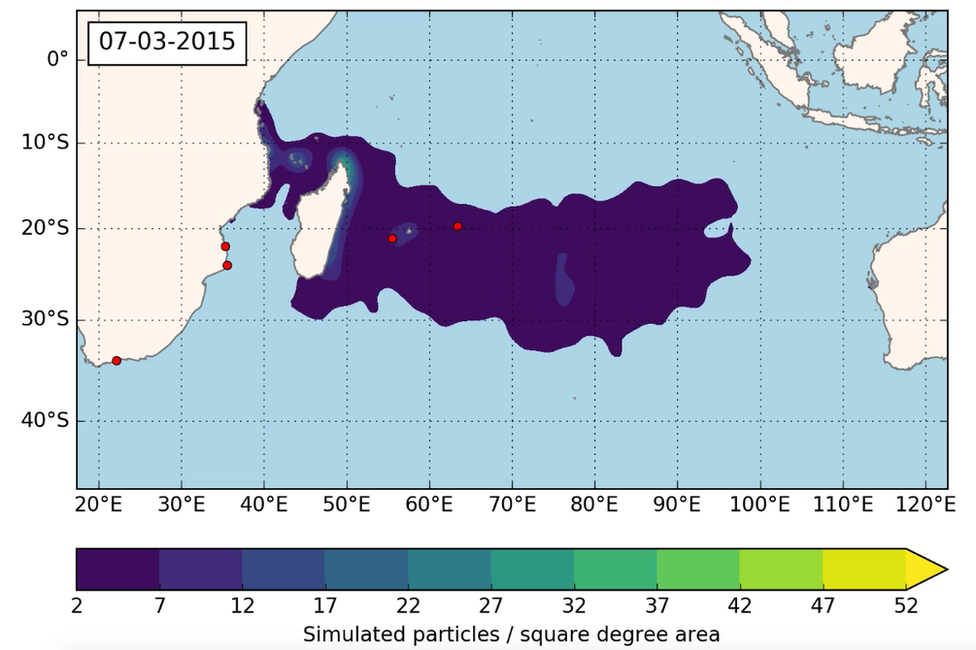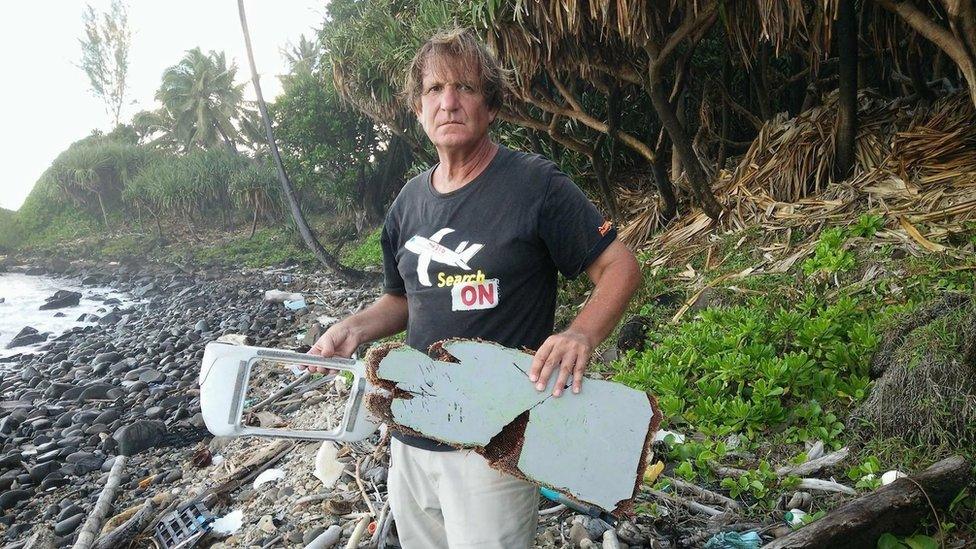MH370: Missing jet 'could be further north'
- Published

Discovered debris (red dots) is used to weight the outcomes of multiple simulations
The crashed remains from the Malaysia Airlines Flight MH370 could be as much as 500km further north than the current search area, say scientists in Italy.
Their assessment is based on the location of confirmed debris items and computer modelling that incorporates ocean and weather data.
They say this has allowed them to determine where the plane most likely hit the water and where future aircraft fragments might wash up.
The MH370 search will soon be halted.
The Malaysia Airlines flight disappeared in March 2014, en route from Malaysia's capital Kuala Lumpur to Beijing in China, with 239 passengers and crew on board.
Authorities have agreed that "in the absence of new credible evidence" the effort to find the plane on the ocean floor west of Australia will be suspended once a zone covering 120,000 square km has been fully surveyed.
That could happen in the next few weeks.
The Australian Transport Safety Bureau, which is co-ordinating the search, has previously said it is confident, external it is looking in the most plausible place.
A team led by Eric Jansen, from the Euro-Mediterranean Center on Climate Change, external in Italy, is the latest to try its hand at using modelling to identify the impact site.
The approach relies on two years of high-resolution data that describe the currents and wind conditions across the Indian and Southern oceans.
Multiple simulations were used to predict where objects might drift given different starting points.
These forecasts were then analysed and the greatest weight given to those tracks that best matched the locations of known MH370 debris items.
These are the parts of the Boeing 777, such as an engine cowling and wing flap, that have since washed up on the beaches of Africa and Indian-ocean islands.
Eric Jansen: "We use the locations where debris was found to rank the simulations"
The conclusion is that the main wreckage of the plane is likely to be in the wide search area between 28 degrees South and 35 degrees South that was designated by crash investigators.
However, only the southern end of this zone - a priority segment between 32 degrees South and 35 degrees South - is currently being surveyed by underwater cameras and detectors.
This still leaves a swathe of ocean floor to the north where Dr Jansen and colleagues say MH370 could possibly be resting today undiscovered.

The results suggest the plane could be on the ocean floor to the north of the underwater search area
One of the advantages of the type of model produced by the team is that its solutions can be updated as more debris is found.
"We use the location where debris is found to create a ranking of the different simulations. So, the simulations that cause debris in all of the locations where this material was found - we rank those higher; and the ones that are not as good at predicting the locations of the debris - we rank them lower.
"And then we combine the result. This has the benefit that if new debris is found we only have to repeat the ranking, which is very fast, while the simulations of drift over two years take several hours."
This means also that should more debris come to light, the model will refine its solution for where in the ocean the missing jet is most likely to be found.
And given that the underwater search is about to be suspended, Dr Jansen says perhaps greater effort should now be directed towards finding more washed-up debris.
It is an endeavour that would be low-cost, he argues, but would very much aid the type of research he does, while at the same time possibly yielding additional information on the state of the aircraft in its final moments.
Such inferences can be gleaned by examining materials for tell-tale damage.
Dr Jansen and colleagues have published their research in the journal Natural Hazards and Earth System Sciences, external.
Jonathan.Amos-INTERNET@bbc.co.uk, external and follow me on Twitter: @BBCAmos, external
- Published22 July 2016

- Published22 July 2016

- Published10 June 2016
